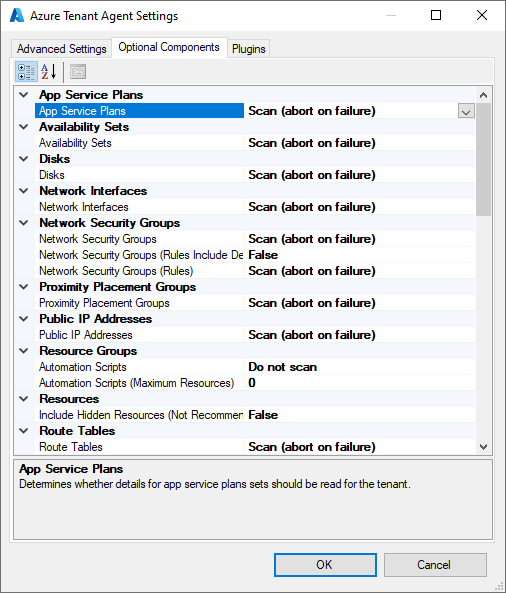Optional Components

App Service Plans
Determines whether details for app service plans sets should be read for the tenant.
Availability Sets
Determines whether details for availability sets should be read for the tenant.
Disks
Determines whether details for managed disks should be read for the tenant.
Network Interfaces
Determines whether details for network interfaces should be read for the tenant.
Network Security Groups
Determines whether details for network security groups should be read for the tenant.
Network Security Groups (Rules)
Determines whether network security group rules should be read for the tenant.
Network Security Groups (Rules Include Default)
Determines whether to include default rules should be included when reading network security group rules.
Proximity Placement Groups
Determines whether details for proximity placement groups should be read for the tenant.
Public IP Addresses
Determines whether the details for public IP addresses should be read for the tenant.
Resource Groups > Automation Scripts
Determines whether the automation scripts should be read for resource groups.
Resource Groups > Automation Scripts (Maximum Resources)
Determines the maximum number of resources a resource group can contain for the automation script to be read.
Valid values are between 1 and 200.
Resources > Include Hidden Resources (Not Recommended)
Determines whether the resources that are hidden in the Azure portal should be included.
Route Tables
Determines whether the route tables should be read for the tenant.
SQL Databases
Determines whether details for SQL databases should be read for the tenant.
SQL Databases (Audit Policy)
Determines whether audit policy details for SQL databases should be read for the tenant.
SQL Databases (Replicas)
Determines whether details for SQL database replicas should be read for the tenant.
SQL Databases (Sync Groups)
Determines whether details for SQL database sync groups should be read for the tenant.
SQL Elastic Pools
Determines whether details for SQL elastic pools should be read for the tenant.
SQL Servers
Determines whether details for SQL servers should be read for the tenant.
SQL Servers (Audit Policy)
Determines whether audit policy for SQL servers should be read for the tenant.
SQL Servers (Failover Groups)
Determines whether the failover groups for SQL servers should be read for the tenant.
SQL Servers (Network Settings)
Determines whether the network settings for SQL servers should be read for the tenant.
SQL Servers (Private Endpoint Connections)
Determines whether the private endpoint connections for SQL servers should be read for the tenant.
SQL Servers (Transparent Data Encryption)
Determines whether the transparent data encryption settings for SQL servers should be read for the tenant.
Storage Accounts
Determines whether details for storage accounts should be read for the tenant.
Subscriptions
Storage Accounts (Access Keys) 1
Determines whether the access keys should be read for storage accounts. This is security sensitive information and is disabled by default.
Subscriptions > Alert Rules
Determines whether the alert rules should be read for each subscription.
Subscriptions > Invoices 1
Determines whether the invoices should be read for each subscription.
Subscriptions > Invoices (Months)
The number of months in the past for which invoices should be read for each subscription. By default this is the last 12 months.
Subscriptions > Policy Assignments
Determines whether the policy assignments should be read for each subscription.
Subscriptions > Locks
Determines whether the resource locks should be read for each subscription.
Subscriptions > Role Assignments
Determines whether the role assignments should be read for each subscription.
Subscriptions > Role Assignments (Include Classic Administrators)
Determines whether the role assignments read for each subscription should include classic administrators.
Tenant Configuration > Management Groups 1
Determines whether the management groups should be read for the tenant.
Tenant Configuration > Role Definitions
Determines whether the role definitions should be read for the tenant.
Tenant Configuration > Role Definitions (Include Built-In)
Determines whether the built-in role definitions should be read for the tenant.
Virtual Machines
Determines whether details for virtual machines should be read for the tenant.
Virtual Machines (Extensions)
Determines whether virtual machine extensions should be read for the tenant.
Virtual Machines (Extensions Public Settings)
Determines the virtual machine extensions for which the public settings should be read.
- None
The public settings should not be read from any extensions. - Default
The public settings should be read from the default extensions. - All
The public settings should be read from all extensions.
Virtual Machines (Network Settings)
Determines whether virtual machine networking information should be read for the tenant.
Virtual Machines (Screenshot) 1
Determines whether screenshots for virtual machines should be read for the tenant.
Virtual Machines (Storage)
Determines whether storage details for virtual machines should be read for the tenant.
Virtual Networks
Determines whether details for virtual networks should be read for the tenant.
Virtual Networks (Peerings)
Determines whether details for the peerings of the virtual networks should be read for the tenant.
Web Apps
Determines whether details of the web apps should be read for the tenant.
Web Apps (Authentication Settings)
Determines whether details of the authentication settings for the web apps should be read for the tenant.
Web Apps (Application Settings) 1
Determines whether details of the app settings for the web apps should be read for the tenant. These may contain security sensitive information.
Web Apps (FTP Publishing Settings)
Determines whether details of the FTP publishing settings for the web apps should be read for the tenant.
Web Apps (FTP Publishing Settings Password) 1
Determines whether the FTP publishing password for the web apps should be read for the tenant.
1 These settings require optional additional permissions.